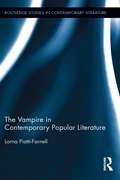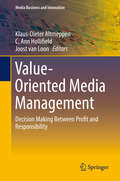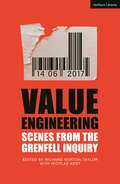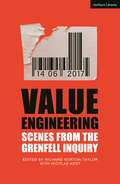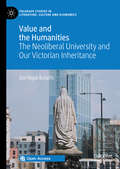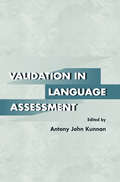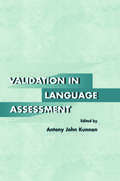- Table View
- List View
The Vampire in Contemporary Popular Literature (Routledge Studies in Contemporary Literature)
by Lorna Piatti-FarnellProminent examples from contemporary vampire literature expose a desire to re-evaluate and re-work the long-standing, folkloristic interpretation of the vampire as the immortal undead. This book explores the "new vampire" as a literary trope, offering a comprehensive critical analysis of vampires in contemporary popular literature and demonstrating how they engage with essential cultural preoccupations, anxieties, and desires. Drawing from cultural materialism, anthropology, psychoanalysis, literary criticism, gender studies, and postmodern thought, Piatti-Farnell re-frames the concept of the vampire in relation to a distinctly twenty-first century brand of Gothic imagination, highlighting important aesthetic, conceptual, and cultural changes that have affected the literary genre in the post-2000 era. She places the contemporary literary vampire within the wider popular culture scope, also building critical connections with issues of fandom and readership. In reworking the formulaic elements of the vampiric tradition — and experimenting with genre-bending techniques — this book shows how authors such as J.R. Ward, Stephanie Meyers, Charlaine Harris, and Anne Rice have allowed vampires to be moulded into enigmatic figures who sustain a vivid conceptual debt to contemporary consumer and popular culture. This book highlights the changes — conceptual, political and aesthetic — that vampires have undergone in the past decade, simultaneously addressing how these changes in "vampire identity" impact on the definition of the Gothic as a whole.
The Vampire: A New History
by Nick GroomAn authoritative new history of the vampire, two hundred years after it first appeared on the literary scene Published to mark the bicentenary of John Polidori’s publication of The Vampyre, Nick Groom’s detailed new account illuminates the complex history of the iconic creature. The vampire first came to public prominence in the early eighteenth century, when Enlightenment science collided with Eastern European folklore and apparently verified outbreaks of vampirism, capturing the attention of medical researchers, political commentators, social theorists, theologians, and philosophers. Groom accordingly traces the vampire from its role as a monster embodying humankind’s fears, to that of an unlikely hero for the marginalized and excluded in the twenty-first century. Drawing on literary and artistic representations, as well as medical, forensic, empirical, and sociopolitical perspectives, this rich and eerie history presents the vampire as a strikingly complex being that has been used to express the traumas and contradictions of the human condition.
Values of German Media Users: 1986 - 2007
by Merja MahrtValues of German media users, 1986-2007 Values have been discussed in connection to the changes brought to the German TV landscape since the introduction of the dual system in 1984. Yet, on such occurrences arguments have rarely, if at all, been based on reliable information about differences in televised values. Nor have values of the audience of channels or genres been considered. This study offers a starting point for such an endeavor, focusing on the role values play for people’s media choices. In a theoretical overview, values are situated in a framework of overlapping spheres that influence people in the adoption of values. Social learning is the main mechanism behind this process of socialization. Values define what is desirable or not and how one should behave in a given situation according to the rules of one’s society. As stable basic traits close to an individual’s personality, values play a part in the building of motives that finally result in behavior. With regard to media, a well-established gratification of media use is the reinforcement of one’s own values and worldviews. Based on the finding that mediated value patterns differ across outlets and types of content, I assume that different values should lead people do prefer different media over others.
Values, Objectivity, and Explanation in Historiography (Routledge Approaches to History #21)
by Tor Egil FørlandBringing sophisticated philosophy to bear on real-life historiography, Values, Objectivity, and Explanation in Historiography rekindles and invigorates the debate on two perennials in the theory and methodology of history. One is the tension between historians' values and the ideal—or illusion—of objective historiography. The other is historical explanation. The point of departure for the treatment of values and objectivity is an exceptionally heated debate on Cold War historiography in Denmark, involving not only historians but also the political parties, the national newspapers, and the courts. The in-depth analysis that follows concludes that historians can produce accounts that deserve the label "objective," even though their descriptions are tinged by ineluctable epistemic instability. A separate chapter dissects the postmodern notion of situated truths. The second part of the book proffers a new take on historical explanation. It is based on the notion of the ideal explanatory text, which allows for not only causal—including intentional—but also nomological, structural, and functional explanations. The approach, which can accommodate narrative explanations driven by causal plots, is ecumenical but not all-encompassing. Emergent social properties and supernatural entities are excluded from the ideal explanatory text, making scientific historiography methodologically individualistic—albeit with room for explanations at higher levels when pragmatically justified—and atheist.
Values, Objectivity, and Explanation in Historiography (Routledge Approaches to History #21)
by Tor Egil FørlandBringing sophisticated philosophy to bear on real-life historiography, Values, Objectivity, and Explanation in Historiography rekindles and invigorates the debate on two perennials in the theory and methodology of history. One is the tension between historians' values and the ideal—or illusion—of objective historiography. The other is historical explanation. The point of departure for the treatment of values and objectivity is an exceptionally heated debate on Cold War historiography in Denmark, involving not only historians but also the political parties, the national newspapers, and the courts. The in-depth analysis that follows concludes that historians can produce accounts that deserve the label "objective," even though their descriptions are tinged by ineluctable epistemic instability. A separate chapter dissects the postmodern notion of situated truths. The second part of the book proffers a new take on historical explanation. It is based on the notion of the ideal explanatory text, which allows for not only causal—including intentional—but also nomological, structural, and functional explanations. The approach, which can accommodate narrative explanations driven by causal plots, is ecumenical but not all-encompassing. Emergent social properties and supernatural entities are excluded from the ideal explanatory text, making scientific historiography methodologically individualistic—albeit with room for explanations at higher levels when pragmatically justified—and atheist.
Values in English Language Teaching
by Bill JohnstonThis book offers a new perspective on language teaching by placing moral issues--that is, questions of values--at the core of what it is to be a teacher. The teacher-student relation is central to this view, rather than the concept of language teaching as merely a technical matter of managing students' acquisition of language. The message is that all language teaching involves an interplay of deeply held values, but in each teaching situation these values are played out in different ways. Johnston does not tell readers what to think, but only suggests what to think about. Values in English Language Teaching explores the complex and often contradictory moral landscape of the language classroom, gradually revealing how teaching is not a matter of clear-cut choices but of wrestling with dilemmas and making difficult decisions in situations often riven with conflict. It examines the underlying values that teachers hold as individuals and as members of their profession, and demonstrates how those values are played out in the real world of language classrooms. Matters addressed include connections between the moral and political dimensions in English language teaching, and between values and religious beliefs; relationship(s) between teacher identity and values; the meaning of professionalism and how it is associated with morality and values; the ways in which teacher development is a moral issue; and the marginality of English language teaching. All the examples are taken from real-life teaching situations--the complexity and messiness of these situations is always acknowledged, including both individual influences and broader social, cultural, and political forces at play in English language classrooms. By using actual situations as the starting point for analysis, Johnston offers a philosophy based in practice, and recognizes the primacy of lived experience as a basis for moral analysis. Examples come from teaching contexts around the world, including Brazil, Thailand, Poland, Japan, Central African Republic, Turkey, and Taiwan, as well as various settings in the United States. This book will change the way teachers see language classrooms--their own or those of others. It is a valuable resource for teachers of ESL and EFL and all those who work with them, especially teacher educators, researchers, and administrators.
Values in English Language Teaching
by Bill JohnstonThis book offers a new perspective on language teaching by placing moral issues--that is, questions of values--at the core of what it is to be a teacher. The teacher-student relation is central to this view, rather than the concept of language teaching as merely a technical matter of managing students' acquisition of language. The message is that all language teaching involves an interplay of deeply held values, but in each teaching situation these values are played out in different ways. Johnston does not tell readers what to think, but only suggests what to think about. Values in English Language Teaching explores the complex and often contradictory moral landscape of the language classroom, gradually revealing how teaching is not a matter of clear-cut choices but of wrestling with dilemmas and making difficult decisions in situations often riven with conflict. It examines the underlying values that teachers hold as individuals and as members of their profession, and demonstrates how those values are played out in the real world of language classrooms. Matters addressed include connections between the moral and political dimensions in English language teaching, and between values and religious beliefs; relationship(s) between teacher identity and values; the meaning of professionalism and how it is associated with morality and values; the ways in which teacher development is a moral issue; and the marginality of English language teaching. All the examples are taken from real-life teaching situations--the complexity and messiness of these situations is always acknowledged, including both individual influences and broader social, cultural, and political forces at play in English language classrooms. By using actual situations as the starting point for analysis, Johnston offers a philosophy based in practice, and recognizes the primacy of lived experience as a basis for moral analysis. Examples come from teaching contexts around the world, including Brazil, Thailand, Poland, Japan, Central African Republic, Turkey, and Taiwan, as well as various settings in the United States. This book will change the way teachers see language classrooms--their own or those of others. It is a valuable resource for teachers of ESL and EFL and all those who work with them, especially teacher educators, researchers, and administrators.
Values and Choices in Television Discourse: A View from Both Sides of the Screen
by Roberta Piazza Louann Haarman Anne CabornThe high-pressured, fast-paced environment of television production leaves little time for producers to reflect on how the potentialities of texts and images will be interpreted outside of the immediate broadcast imperatives. This volume brings together the producers and analysts of television in a formal and productive way.
Value-Oriented Media Management: Decision Making Between Profit and Responsibility (Media Business and Innovation)
by Klaus-Dieter Altmeppen C. Ann Hollifield Joost Van LoonIn the light of a rapidly changing media industry with new technologies, actors and advertising models, and the critical role of media in society, this volume highlights the meaning of different values in media companies and media managers’ decisions. It discusses how economic as well as societal values can be equally integrated in media management processes and how such values affect the internal as well as external environment of media companies. The contributions analyze various issues in media management, such as the relationship between quality and audience demand, the role of branding in building values, changes in the value chain, and the impact of deregulation. Further important topics include hypercompetition, mediatization, challenges for media managers and the meaning of corporate social responsibility.
The Value of Time in Early Modern English Literature
by Tina SkouenThe stigma of haste pervaded early modern English culture, more so than the so-called stigma of print. The period’s writers were perpetually short on time, but what does it mean for authors to present themselves as hasty or slow, or to characterize others similarly? This book argues that such classifications were a way to define literary value. To be hasty was, in a sense, to be irresponsible, but, in another sense, it signaled a necessary practicality. Expressions of haste revealed a deep conflict between the ideal of slow writing in classical and humanist rhetoric and the sometimes grim reality of fast printing. Indeed, the history of print is a history of haste, which carries with it a particular set of modern anxieties that are difficult to understand in the absence of an interdisciplinary approach. Many previous studies have concentrated on the period’s competing definitions of time and on the obsession with how to use time well. Other studies have considered time as a notable literary theme. This book is the first to connect ideas of time to writerly haste in a richly interdisciplinary manner, drawing upon rhetorical theory, book history, poetics, religious studies and early modern moral philosophy, which, only when taken together, provide a genuinely deep understanding of why the stigma of haste so preoccupied the early modern mind. The Value of Time in Early Modern English Literature surveys the period from ca 1580 to ca 1730, with special emphasis on the seventeenth century. The material discussed is found in emblem books, devotional literature, philosophical works, and collections of poetry, drama and romance. Among classical sources, Horace and Quintilian are especially important. The main authors considered are: Robert Parsons; Edmund Bunny; King James 1; Henry Peacham; Thomas Nash; Robert Greene; Ben Jonson; Margaret Cavendish; John Dryden; Richard Baxter; Jonathan Swift; Alexander Pope. By studying these writers’ expressions of time and haste, we may gain a better understanding of how authorship was defined at a time when the book industry was gradually taking the place of classical rhetoric in regulating writers’ activities.
The Value of Time in Early Modern English Literature
by Tina SkouenThe stigma of haste pervaded early modern English culture, more so than the so-called stigma of print. The period’s writers were perpetually short on time, but what does it mean for authors to present themselves as hasty or slow, or to characterize others similarly? This book argues that such classifications were a way to define literary value. To be hasty was, in a sense, to be irresponsible, but, in another sense, it signaled a necessary practicality. Expressions of haste revealed a deep conflict between the ideal of slow writing in classical and humanist rhetoric and the sometimes grim reality of fast printing. Indeed, the history of print is a history of haste, which carries with it a particular set of modern anxieties that are difficult to understand in the absence of an interdisciplinary approach. Many previous studies have concentrated on the period’s competing definitions of time and on the obsession with how to use time well. Other studies have considered time as a notable literary theme. This book is the first to connect ideas of time to writerly haste in a richly interdisciplinary manner, drawing upon rhetorical theory, book history, poetics, religious studies and early modern moral philosophy, which, only when taken together, provide a genuinely deep understanding of why the stigma of haste so preoccupied the early modern mind. The Value of Time in Early Modern English Literature surveys the period from ca 1580 to ca 1730, with special emphasis on the seventeenth century. The material discussed is found in emblem books, devotional literature, philosophical works, and collections of poetry, drama and romance. Among classical sources, Horace and Quintilian are especially important. The main authors considered are: Robert Parsons; Edmund Bunny; King James 1; Henry Peacham; Thomas Nash; Robert Greene; Ben Jonson; Margaret Cavendish; John Dryden; Richard Baxter; Jonathan Swift; Alexander Pope. By studying these writers’ expressions of time and haste, we may gain a better understanding of how authorship was defined at a time when the book industry was gradually taking the place of classical rhetoric in regulating writers’ activities.
The Value of Foreign Language Learning: A Study on Linguistic Capital and the Economic Value of Language Skills
by Tobias SchroedlerBased on a highly interdisciplinary theoretical framework, Tobias Schroedler provides a comprehensive picture of the value of language skills within the Irish economy. The author manages to present and merge theories from economics, business studies, sociology, and applied linguistics making this an innovative and valuable contribution to the growing field of research on the value of multilingualism and languages. The first of two datasets presented in the book provides a macroeconomic quantification on the economic performance of four different global language communities. The second dataset consists of an expert interview study on the matter. Based on the data analysis, the author derives recommendations for economically beneficial language education policy making.
The Value of Conversation: Perspectives from Antiquity to Modernity
by Christoph StrosetzkiWhat is the value of conversation measured by? Are there more valuable and inferior types of conversation? What role do the contents, the people, and the circumstances play? Do times and epochs shape their own conversations? Conversation norms from handbooks as well as conversations reproduced in texts or reconstructed from texts shed light on these questions. The contributions in this volume are grouped around conceptual questions, specific contexts such as the salon and the table conversation, bring studies on individual literary texts and cover the European cultural history from Plato to the 20th century.
Value in Art: Manet and the Slave Trade
by Henry M. SayreArt historian Henry M. Sayre traces the origins of the term “value” in art criticism, revealing the politics that define Manet’s art. How did art critics come to speak of light and dark as, respectively, “high in value” and “low in value”? Henry M. Sayre traces the origin of this usage to one of art history’s most famous and racially charged paintings, Édouard Manet’s Olympia. Art critics once described light and dark in painting in terms of musical metaphor—higher and lower tones, notes, and scales. Sayre shows that it was Émile Zola who introduced the new “law of values” in an 1867 essay on Manet. Unpacking the intricate contexts of Zola’s essay and of several related paintings by Manet, Sayre argues that Zola’s usage of value was intentionally double coded—an economic metaphor for the political economy of slavery. In Manet’s painting, Olympia and her maid represent objects of exchange, a commentary on the French Empire’s complicity in the ongoing slave trade in the Americas. Expertly researched and argued, this bold study reveals the extraordinary weight of history and politics that Manet’s painting bears. Locating the presence of slavery at modernism’s roots, Value in Art is a surprising and necessary intervention in our understanding of art history.
Value in Art: Manet and the Slave Trade
by Henry M. SayreArt historian Henry M. Sayre traces the origins of the term “value” in art criticism, revealing the politics that define Manet’s art. How did art critics come to speak of light and dark as, respectively, “high in value” and “low in value”? Henry M. Sayre traces the origin of this usage to one of art history’s most famous and racially charged paintings, Édouard Manet’s Olympia. Art critics once described light and dark in painting in terms of musical metaphor—higher and lower tones, notes, and scales. Sayre shows that it was Émile Zola who introduced the new “law of values” in an 1867 essay on Manet. Unpacking the intricate contexts of Zola’s essay and of several related paintings by Manet, Sayre argues that Zola’s usage of value was intentionally double coded—an economic metaphor for the political economy of slavery. In Manet’s painting, Olympia and her maid represent objects of exchange, a commentary on the French Empire’s complicity in the ongoing slave trade in the Americas. Expertly researched and argued, this bold study reveals the extraordinary weight of history and politics that Manet’s painting bears. Locating the presence of slavery at modernism’s roots, Value in Art is a surprising and necessary intervention in our understanding of art history.
Value Engineering: Scenes from the Grenfell Inquiry (Modern Plays)
by Richard Norton-TaylorValue Engineering: Scenes from the Grenfell Inquiry is a verbatim reconstruction of the Grenfell Tower Public Inquiry. Using only the words spoken at the Inquiry, the play deals predominantly with Part 2 which ran between January 2020 - July 2021 in which evidence was heard from those responsible for the disastrous refurbishment of Grenfell Tower before the tragic fire.Edited by Richard Norton-Taylor and directed by Nicholas Kent, the team behind previous testimonial plays The Colour of Justice: The Stephen Lawrence Inquiry and Bloody Sunday: Scenes from the Saville Inquiry, this edited verbatim account of the Grenfell Inquiry is aimed at giving the public an overview and access to some of the most important evidence.The play shows how companies involved in the refurbishment of the Tower conspired to cover up what they knew about the dangerous and life-threatening materials used to refurbish the Tower. It also reveals the incompetence and neglect of local authorities.Staged in Notting Hill Tabernacle in October 2021, this features the full text of the play alongside additional information on the context of Grenfell and the ongoing inquiry.
Value Engineering: Scenes from the Grenfell Inquiry (Modern Plays)
by Richard Norton-TaylorValue Engineering: Scenes from the Grenfell Inquiry is a verbatim reconstruction of the Grenfell Tower Public Inquiry. Using only the words spoken at the Inquiry, the play deals predominantly with Part 2 which ran between January 2020 - July 2021 in which evidence was heard from those responsible for the disastrous refurbishment of Grenfell Tower before the tragic fire.Edited by Richard Norton-Taylor and directed by Nicholas Kent, the team behind previous testimonial plays The Colour of Justice: The Stephen Lawrence Inquiry and Bloody Sunday: Scenes from the Saville Inquiry, this edited verbatim account of the Grenfell Inquiry is aimed at giving the public an overview and access to some of the most important evidence.The play shows how companies involved in the refurbishment of the Tower conspired to cover up what they knew about the dangerous and life-threatening materials used to refurbish the Tower. It also reveals the incompetence and neglect of local authorities.Staged in Notting Hill Tabernacle in October 2021, this features the full text of the play alongside additional information on the context of Grenfell and the ongoing inquiry.
Value and the Humanities: The Neoliberal University and Our Victorian Inheritance (Palgrave Studies in Literature, Culture and Economics)
by Zoe Hope BulaitisTracing the shift from liberal to neoliberal education from the nineteenth century to the present day, this open access book provides a rich and previously underdeveloped narrative of value in higher education in England. Value and the Humanities draws upon historical, financial, and critical debates concerning educational and cultural policy. Rather than writing a singular defence of the humanities against economic rationalism, Zoe Hope Bulaitis constructs a nuanced map of the intersections of value in the humanities, encompassing an exploration of policy engagement, scientific discourses, fictional representation, and the humanities in public life. The book articulates a kaleidoscopic range of humanities practices which demonstrate that although recent policy encourages higher education to be entirely motivated by outcomes, fiscal targets, and the acquisition of employability skills, the humanities continue to inspire and aspire beyond these limits. This book is a historically-grounded and theoretically-informed analysis of the value of the humanities within the context of the market.
Validity, Reliability, and Significance: Empirical Methods for NLP and Data Science (Synthesis Lectures on Human Language Technologies)
by Stefan Riezler Michael HagmannEmpirical methods are means to answering methodological questions of empirical sciences by statistical techniques. The methodological questions addressed in this book include the problems of validity, reliability, and significance. In the case of machine learning, these correspond to the questions of whether a model predicts what it purports to predict, whether a model's performance is consistent across replications, and whether a performance difference between two models is due to chance, respectively. The goal of this book is to answer these questions by concrete statistical tests that can be applied to assess validity, reliability, and significance of data annotation and machine learning prediction in the fields of NLP and data science. Our focus is on model-based empirical methods where data annotations and model predictions are treated as training data for interpretable probabilistic models from the well-understood families of generalized additive models (GAMs) and linear mixed effects models (LMEMs). Based on the interpretable parameters of the trained GAMs or LMEMs, the book presents model-based statistical tests such as a validity test that allows detecting circular features that circumvent learning. Furthermore, the book discusses a reliability coefficient using variance decomposition based on random effect parameters of LMEMs. Last, a significance test based on the likelihood ratio of nested LMEMs trained on the performance scores of two machine learning models is shown to naturally allow the inclusion of variations in meta-parameter settings into hypothesis testing, and further facilitates a refined system comparison conditional on properties of input data. This book can be used as an introduction to empirical methods for machine learning in general, with a special focus on applications in NLP and data science. The book is self-contained, with an appendix on the mathematical background on GAMs and LMEMs, and with an accompanying webpage including R code to replicate experiments presented in the book.
Validation in Language Assessment
by Antony John KunnanValidation in Language Assessment contributes to the variety of validation approaches and analytical and interpretive techniques only recently adopted by language assessment researchers. Featuring selected papers from the 17th Language Testing Research Colloquium, the volume presents diverse approaches with an international perspective on validation in language assessment.
Validation in Language Assessment
by Antony John KunnanValidation in Language Assessment contributes to the variety of validation approaches and analytical and interpretive techniques only recently adopted by language assessment researchers. Featuring selected papers from the 17th Language Testing Research Colloquium, the volume presents diverse approaches with an international perspective on validation in language assessment.
The Valiant Black Man in Flanders / El valiente negro en Flandes: by Andrés de Claramonte (Aris & Phillips Hispanic Classics)
A play about defiance of systemic racism. Juan de Mérida, an Afro-Spanish soldier aspires to social advancement in the Netherlands during the Eighty Years' War (1566-1648). His main enemies are not Dutch rebels but his white countrymen, whom he defeats at every attempt to humiliate him. In this play one encounters military culture, upward mobility, mistaken identities, defying destiny, royal pageantry, swordfights, cross-dressing, revenge, homosexual anxiety, and inter-racial marriage. Andrés de Claramonte’s El valiente negro en Flandes (c.1625) is an Afrodiasporic play that enjoyed great success and multiple stagings in Spain and in Latin America. Its 1938 negrista performance in Havana, Cuba, and Frantz Fanon’s Black Skin, White Masks, attest to the power of this play to illuminate contemporary racial dynamics. This is the first annotated, critical edition and English translation of El valiente negro en Flandes with a comprehensive introduction, three critical essays, the critical apparatus comparing the eleven extant versions of the play, and an appendix with alternative scenes and related historical documents. A tool for scholars of early modern European literature and a pedagogical aid to discuss the early discourses on Blackness in Spain and its trans-Atlantic empire.
Valerius Flaccus and Imperial Latin Epic
by Tim StoverThis is the first book-length study of the reception of Valerius Flaccus' Argonautica in the epic poems of Silius Italicus (Punica), Statius (Thebaid, Achilleid), and Claudian (De Raptu Proserpinae). It sheds new light on the importance of Valerius' poem and enhances our understanding of the intertextual richness of imperial Latin epic. The readings offered in this book provide new evidence to support the view that Valerius' Argonautica predates the Punica and Thebaid, thus helping to clarify the literary history of the Flavian period (69-96 CE). Stover shows how Silius, Statius, and Claudian use programmatic allusion to the Argonautica to present themselves as Valerius' epic successors. Silius, Statius, and Claudian rework Valerian material to achieve various effects; analysis of these effects is organized by the primary function of allusive interactions, such as 'reversal', 'enrichment', and 'contrast'. This study is essential for scholars of Latin epic poetry. Yet the Greek and Latin of its close readings are translated, making it accessible to all readers interested in intertextuality, comparative literature, and other related topics.
Valerius Flaccus and Imperial Latin Epic
by Tim StoverThis is the first book-length study of the reception of Valerius Flaccus' Argonautica in the epic poems of Silius Italicus (Punica), Statius (Thebaid, Achilleid), and Claudian (De Raptu Proserpinae). It sheds new light on the importance of Valerius' poem and enhances our understanding of the intertextual richness of imperial Latin epic. The readings offered in this book provide new evidence to support the view that Valerius' Argonautica predates the Punica and Thebaid, thus helping to clarify the literary history of the Flavian period (69-96 CE). Stover shows how Silius, Statius, and Claudian use programmatic allusion to the Argonautica to present themselves as Valerius' epic successors. Silius, Statius, and Claudian rework Valerian material to achieve various effects; analysis of these effects is organized by the primary function of allusive interactions, such as 'reversal', 'enrichment', and 'contrast'. This study is essential for scholars of Latin epic poetry. Yet the Greek and Latin of its close readings are translated, making it accessible to all readers interested in intertextuality, comparative literature, and other related topics.
Valencian Folktales, Volume 2: Enric Valor (Routledge Studies in Twentieth-Century Literature #2)
by Paul Scott Derrick Maria-Lluïsa Gea-ValorEnric Valor (1911–2000) is one of the most important Valencian authors of the 20th century. He has been, until now, almost completely unknown to an English-speaking audience. Following the publication of Valencian Folktales (2023), this second collection of his tales will help to consolidate work done on Valor in English, opening up both his fiction and the specificity of Valencian culture to Anglophone readers. The stories included here offer a sampling of the various types of tales he wrote: magical-theme tales, local-color tales and tales with personified animals. Valor collected these stories from the inhabitants of small towns and villages in the south of the Valencian territory and later gave them a polished, literary reworking. They are characterized by a detailed and lyrical treatment of the landscape and natural habitat of the region and an entertaining sense of humor. The selection begins with an introduction written by Maria-Lluisa Gea-Valor, co-translator and the author’s granddaughter. It provides a brief background to Valor’s biography, discusses the selected tales in the context of the folklore tradition and examines issues of the translation process, ranging from general considerations to more specific aspects.
